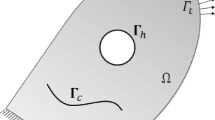Abstract
An iterative method to determine the location and size of flaws using dynamic response measurements is presented. The solution procedure combines frequency-domain problem solving methods (deconvolution and the spectral element method) with a stochastic iterative search technique based on a genetic algorithm. Experimentally measured acceleration and strain responses from example structures are used to verify the method.
Similar content being viewed by others
Author information
Authors and Affiliations
Rights and permissions
About this article
Cite this article
Kannal, L., Doyle, J. Combining spectral super-elements, genetic algorithms, and massive parallelism for computationally efficient flaw detection in complex structures. Computational Mechanics 20, 67–74 (1997). https://doi.org/10.1007/s004660050218
Published:
Issue Date:
DOI: https://doi.org/10.1007/s004660050218




